
Wednesday August 27, 2003
CARTRIX HYUNDAI ACCENT
"Maxi-Tuning"
By Rob Wessling
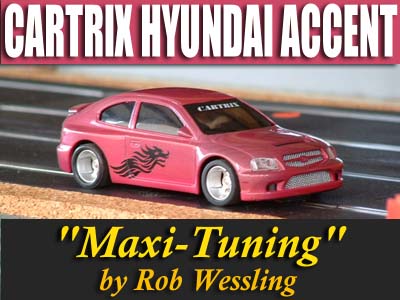 Having
become familiar with the Cartrix company by way of their excellent BMW Z3 and
Porsche Boxster releases, I was very keen to try some of the other models in the
Cartrix range. The opportunity recently came about to put the Cartrix Hyundai
Accent "Maxi-Tuning" through it's paces on our home circuit,
MILLENNIUM RACEWAY.
Having
become familiar with the Cartrix company by way of their excellent BMW Z3 and
Porsche Boxster releases, I was very keen to try some of the other models in the
Cartrix range. The opportunity recently came about to put the Cartrix Hyundai
Accent "Maxi-Tuning" through it's paces on our home circuit,
MILLENNIUM RACEWAY.
On first inspection of this model I must say I was a little skeptical regarding performance etc. This was for the most part due to the subject that the model in question is based on. Hyundai Accent's are plentiful and cheap over here in Oz, you do see them customized for street use by their owners (generally the younger crowd), not exactly my cup of tea in day to day life, but hey, we were all young once, right?
Closer examination of the Maxi-Tuning Accent showed the overall fit and finish of the body to be first rate. The wild Magenta metallic paint has no imperfections (runs, trapped dust, etc.). My example is absolutely flawless in this regard. Please note that the Hyundai Maxi-Tuning comes in a variety of colors, check with your Cartrix dealer for more info.
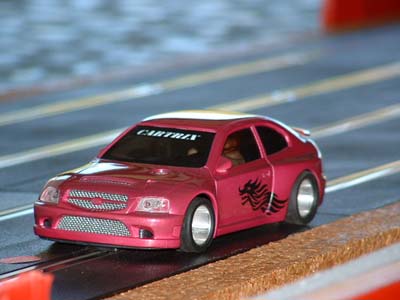
Decals are minimal on this model, being confined to a Cartrix decal on the windscreen, dragon motif on the doors and a number plate on the rear panel. The only fault to be found in this area is that the number plate is slightly askew on this model. In my view this is a very minor issue, a small fault when considering the quality of the rest of the car.
Detail on the Hyundai Accent Maxi-Tuning is modest when compared to that found on other, more expensive models currently on the market. Having said this, the detail present is first class, having real metal mesh grilles for radiator, intercooler and what appears to be a cooling vent on top of the bonnet for an undoubtedly ''hot'' turbo installation. The Hyundai Maxi-Tuning sits on very ''trick'' three spoke alloy wheels, with ''aggressive'' low profile rubber tires to provide it with additional, no nonsense street look. Scale discs rotors (ventilated of course!) round out this quality wheel and tire package. Incidentally, the wheels and disc rotors are available from Cartrix as separate spare parts, thereby giving hobbyists the option of using them on other models (both Cartrix and other brands).
The darkly tinted windows conceal a race kitted (half) driver figure complete with full face helmet (Hey, I wonder if this little bloke is giving me a hint as to the cars performance potential or what?). He sits in a very basic half tray type cockpit, detail is minimal, but I'm starting to think that there is more to the Cartrix Hyundai Maxi-Tuning than initially meets the eye.
Three screws (two front, one rear) are used to attach body and chassis. With the body removed we find a very neatly laid out chassis, utilizing the tried and true mid engine in-line layout and ''beam'' front axle.
The guide is a standard type two-braid type, using the familiar ''eyelet'' type cable connectors familiar to many brands currently on the market. An interesting addition in this area is the inclusion of a very fine metal guide return spring that runs through a groove on the top of the guide shaft and attaches to either side of the guide cut out on the chassis. I normally do away with guide return springs on models such as the various Scalextric Sport releases. They seem to be more trouble than they are worth, but I decided to leave the spring in place on the Cartrix Hyundai, as I feel that it does function as it is meant to.
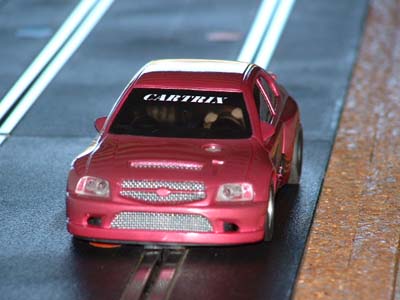
The front axle assembly consists of a steel axle that fits snugly into brass bushings. The bushings are unique in that they have an integral extension sleeve that extend outwards from the bushing face. I find this a positive feature for two reasons, firstly the bushing supports the axle over a longer distance, which should help in minimizing axle free play. Secondly the wheel hub and end of the extension shaft offer less surface area when in contact with each other. This should make for less friction, albeit minimal, but every little bit counts!
I did find some looseness where the axle bushings clip into the chassis, this is not uncommon in many 1/32 scale models, it is easily fixed however, by putting a small amount of crazy/super glue on the bushings and gently clicking them into position.
The motor for this little beast is the Cartrix TX 2.3 (ref.1164), providing a stated 21,500RPM and 330g/cm of torque @15v. This motor has the same can as a Ninco NC-2 type motor. Gearing for the Cartrix Hyundai Maxi-Tuning is by way of a 9 tooth metal pinion and a 25 tooth spur gear. Stock tires are right on 20mm in diameter, so using the formula:-
|
No. of pinion teeth X 3.141 (pie) X Tire Diameter ¸ No. of spur teeth = Millimeters per revolution** |
We find the overall gearing for this model is 22.62 mm per rev.
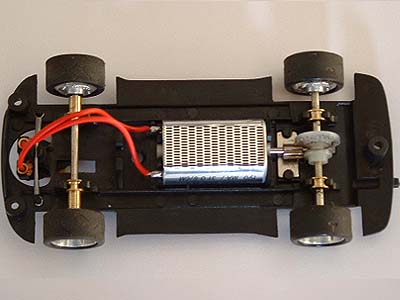 **This
is by far and away the most accurate way to measure the gearing for slot cars
(or anything else with wheels for that matter!). For more information on
millimeters per revolution, please feel free to call in on the Millennium
Raceway web-site and take a look in Rob's Workshop. We'll leave this topic here
for the minute, don't worry we'll make further use of the formula shortly.**
**This
is by far and away the most accurate way to measure the gearing for slot cars
(or anything else with wheels for that matter!). For more information on
millimeters per revolution, please feel free to call in on the Millennium
Raceway web-site and take a look in Rob's Workshop. We'll leave this topic here
for the minute, don't worry we'll make further use of the formula shortly.**
A rectangular Neo magnet positioned forward of the rear axle provides the wonderful ''high downforce'' feel (Hey I like it!). The magnet used in the Hyundai Maxi-Tuning is the same type as used in the Cartrix BMW Z3 and Porsche Boxster releases. Being of similar dimensions to the Fly B73 bar magnet, I had the feeling that this magnet would be up to the task of keeping this little beauty in contact with the track.
The rear axle assembly sits snugly in brass bushings, with no excess movement being present. The bushings here as with the front did however spin in the chassis mounts, again easily fixed by a drop or two of crazy/super glue applied to the outer surface of the bush and gently pressing them into the chassis mounts.
Ahh, time now for the big question, HOW DID THE CARTRIX HYUNDAI MAXI-TUNING PERFORM?? The short answer is SUPERBLY…. (but you're not going to escape my ruminations that easily!).
Whenever I get a new car for our ''scale garage'' I always like to try it out straight from the box to see how it goes. (I'm impatient by nature, it'd kill me to go through all of the car prep business first, just check first to see that the manufacturer has lubed it prior to shipping, OK?). Initial expectations for the Hyundai Maxi-Tuning were high, as we knew the earlier Cartrix releases were very quick creations.
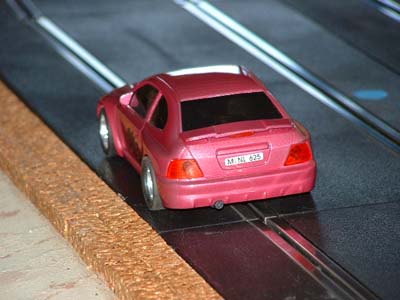 I
was not to be disappointed with the Maxi-Tuning, on it's first ten lap bracket
around our 17.5 meter average lane length Scalextric Sport layout turned in a
best time of 5.6 seconds on lane 2. This is a pretty decent pace around our
circuit, by comparison our stock Scalextric Sport MG Lola's turn in best times
around the 5.7 second mark, the Scalextric Sport '70 Boss Trans-am runs around
5.4-5.5 seconds. The lap record for our layout is 5.3 seconds on lane 2, being
held by a Fly Viper with Fly ''Race'' spec motor (Blue label). So as can be
seen, the Hyundai Maxi-Tuning is certainly running with some ''fast company''.
I
was not to be disappointed with the Maxi-Tuning, on it's first ten lap bracket
around our 17.5 meter average lane length Scalextric Sport layout turned in a
best time of 5.6 seconds on lane 2. This is a pretty decent pace around our
circuit, by comparison our stock Scalextric Sport MG Lola's turn in best times
around the 5.7 second mark, the Scalextric Sport '70 Boss Trans-am runs around
5.4-5.5 seconds. The lap record for our layout is 5.3 seconds on lane 2, being
held by a Fly Viper with Fly ''Race'' spec motor (Blue label). So as can be
seen, the Hyundai Maxi-Tuning is certainly running with some ''fast company''.
Wanting to get the most from the Cartrix Hyundai, I decided to prep it as per usual procedure. Basically all I did with this model is glue in front and rear axle bushings and lightly sand the standard tires, which by the way were very true, I just wanted to clean up a little molding flash. The rims were perfect (as you'd expect machined alloy components to be), which only left ''running in'' of the driveline. I did this by removing all oil and grease from the pinion and spur, lightly coating both with Turtle Wax car polish and running at low RPM for a couple of minutes. Once finished remove excess wax and lightly oil/grease them (now is also a good time to oil the axle bushings and motor bearings).
Back on track for some further testing, the Hyundai Maxi-Tuning turned in a best lap time of 5.4 seconds. Not a huge gain in performance (I expected as much, as the car was well put together to begin with). This performance puts it right up there with our Fly Viper and Scalextric Sport Boss Mustang, which is pretty decent for a plastic chassis slot car.
The Maxi-Tuning handles our Sport layout with ease, having high levels of grip and very good acceleration. Top end speed is not (quite) up there with our Fly race motor equipped Fly viper, but it is far easier to drive consistently, something important if you're contemplating using the Hyundai for club racing. If you're keen on high magnetic downforce cars that really perform, this one is for you.
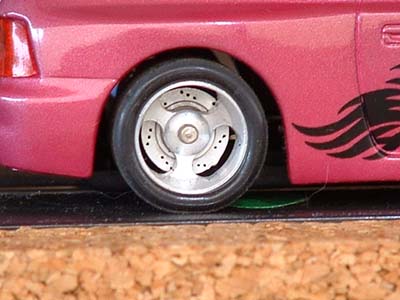 Having
gone as far as I could in regard to performance with the stock components of the
model, I thought I'd try some Cartrix 19X9mm ''Special Rubber'' slick tires
(ref.1123) to see how they went. These tires are a very soft, pliable rubber
compound, they are very well molded and fit most rally type rims/cars from the
various manufacturers (there's a tip for you scale rally enthusiasts, I wish I
had them last week for the Rally leg of the Summer Challenge!).
Having
gone as far as I could in regard to performance with the stock components of the
model, I thought I'd try some Cartrix 19X9mm ''Special Rubber'' slick tires
(ref.1123) to see how they went. These tires are a very soft, pliable rubber
compound, they are very well molded and fit most rally type rims/cars from the
various manufacturers (there's a tip for you scale rally enthusiasts, I wish I
had them last week for the Rally leg of the Summer Challenge!).
An additional benefit with these tires is that being a smaller diameter to the standard rubber (20X11mm versus 19X9.5mm), they will effectively reduce the overall gearing** of the model (stock 22.62mm per rev, versus 21.55mm per rev). In most instances I have found the stock gearing on various models to be over geared for our layout, the Maxi-Tuning being no exception (marginally). Cosmetically the smaller rear tires provide a more scale appearance to the Hyundai, as the full sized version in Australia comes in front wheel drive only, therefore negating the need for big rubber on the tail end. After sanding them very lightly to clean off any excess molding flash, I proceeded to run the little beast around for some ten lap brackets.
The best time was a 4.9 second lap! Absolutely amazing, this is the first model to break into the ''fours'' on our home circuit, I was ecstatic with the results. I ran some more laps in case that the 4.9 second lap was a one off fluke, the good news is that I was able to manage this time on several occasions.
The Maxi-Tuning now exhibited very high levels of grip, with predictable and stable handling, although at the ragged edge the rear would let go with little prior warning (typical trait of high magnetic downforce models). The TX 2.3 motor was found to be a most willing performer, having a nice, wide torque curve to provide plenty of ''grunt'' to propel it out of some of Millennium Raceway's tighter sections of track.
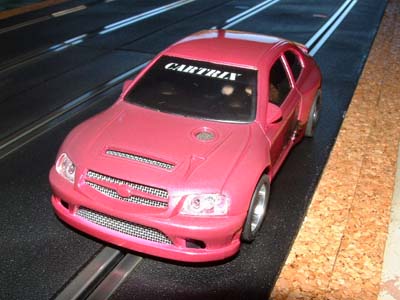 In
closing, I found the CARTRIX HYUNDAI MAXI-TUNING to be an excellent 1/32 scale
model slot car, having great performance, quality components, above average
finish and definitely more than a little street credibility. After much testing
(Hey, I love running it…) I found this model to be very durable, having survived
a few high impacts, the car still looks as good as when it came out of the
packaging. Perhaps not everyone's cup of tea regarding body type, but if you're
into no-nonsense performance, this car is for you.
In
closing, I found the CARTRIX HYUNDAI MAXI-TUNING to be an excellent 1/32 scale
model slot car, having great performance, quality components, above average
finish and definitely more than a little street credibility. After much testing
(Hey, I love running it…) I found this model to be very durable, having survived
a few high impacts, the car still looks as good as when it came out of the
packaging. Perhaps not everyone's cup of tea regarding body type, but if you're
into no-nonsense performance, this car is for you.
Many thanks to CARTRIX for providing 1/32 slot car enthusiasts with a first class model. The Hyundai Accent ''Maxi-Tuning'' certainly seems to be a ''winner'' in our household at least, with family Wessling putting in orders for more of these wonderful cars. Also, please stay tuned for more news on the upcoming Cartrix NSX release (due out in September), early reports indicate more of the same performance that CARTRIX is becoming well known for.
- Rob
Thanks again go to Cartrix for providing us with this model!
We invite all slot car enthusiasts to stop in and visit our home site!